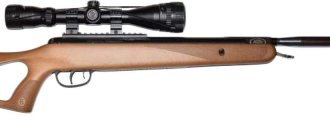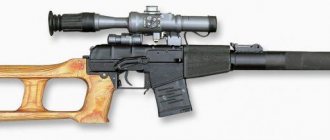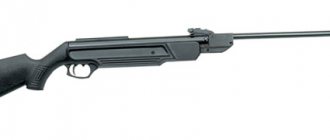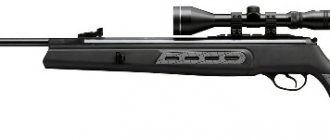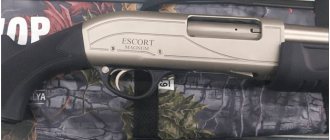Description and design
The IZH-22 rifle has a spring-piston mechanism and a breaking barrel. The bullet is pushed out of the barrel by an air wave created by the movement of the piston. The piston is launched when the spring straightens.
To reload, the barrel is folded down from the butt, as if broken, and a cartridge is inserted inside. The weapon is reloaded before each shot. Charges - lead bullets.
Main characteristics of the rifle:
- single-barrel;
- single-shot;
- rifled.
The barrel is made of steel, the butt is made of wood or plastic. The charge is accelerated and precisely directed thanks to the rifling on the barrel. On average, a bullet flies 165 meters per second.
The IZH-22 rifle is easy to handle and learn to shoot. Despite the simplicity of the mechanism, the weapon is accurate. Experienced shooters hit the match head from a distance of 5 meters.
Pneumatic hunting weapons: well forgotten old
Rifle PCP Hatsan 44-10, cal.
4.5 mm Air guns were originally created as an alternative to firearms. Gradually, it became of interest to the military and at a certain period was even actively used by some armies. However, the development of firearm systems eventually led to the fact that air guns are now used mainly for training and for the so-called. entertaining shooting. It is worth noting that in our country, pneumatic weapons for this purpose have become widespread, which is why other classes of “pneumatics” may be unknown to the general public.
Only relatively recently, literally a couple of decades ago, domestic gun enthusiasts learned that air rifles can be used not only for target shooting, but also for hunting. The capabilities of the weapon, which uses several special technical solutions, allow you to hunt various small game without resorting to powerful firearms. At the same time, in our country there are restrictions on the power of hunting pneumatic weapons and on the scope of their use. According to Russian legislation, pneumatic weapons are divided into several classes. Thus, samples for sports, educational or entertainment purposes must have a muzzle energy of no more than 7.5 J. Hunting pneumatic weapons, in turn, can fire a bullet with an energy of up to 25 J. “Pneumatics” with high energies are not provided for by law, which imposes corresponding prohibitions on its acquisition and use. Pneumatic weapons with muzzle energy up to 25 J, like firearms, require appropriate permission and are registered with the Ministry of Internal Affairs.
Hunting airguns can actually have any design, but currently the most common are rifles with a spring-piston mechanism and pre-pumping (PCP or Pre-Charge Pneumatics). Only these systems provide the necessary power and reliability of shooting. It is worth mentioning that hunting class rifles have a system with a built-in cylinder for compressed gas that provides a shot. The PCP system has several advantages over others and is therefore more convenient for hunting weapons.
The most interesting feature of PCP rifles that attracts the attention of hunters is the almost complete absence of recoil. In the design of such weapons there are no large moving elements, and the impulse received when the bullet moves is extremely small and is almost not felt. In this regard, in particular, it becomes possible to use any suitable sighting devices, mounts, etc. However, shooters often approach the choice of sights and other “body kit” with great responsibility.
Hunting air rifles most often have a caliber of 5.5 or 6.35 mm. This caliber allows the weapon to achieve the required energy levels. In the case of 4.5 mm caliber bullets, the mass of which does not exceed 0.5-1 g, overcoming the conventional barrier of 10-12 J becomes a complex design task associated with increasing the initial velocity of the bullet. For this reason, larger caliber ammunition is most often used in hunting weapons with energy up to 25 J. It is worth noting that abroad there are air rifles of .45 (11.45 mm) or .50 (12.7 mm) calibers, but in almost all cases these weapons are made to order and in accordance with the requirements of a particular shooter. Most hunters use medium caliber weapons - no more than 6.35 mm.
All modern PCP rifles designed for hunting have a similar appearance. Manufacturers use a common architecture, changing some elements or using their own developments regarding materials. All rifle components are mounted on a wooden or plastic stock. The shape and material of this part are chosen by the designers and affect mainly the ease of use of the weapon, but not its characteristics. The stock is equipped with a barrel, a trigger mechanism with a bullet supply system, as well as a gas system, which ensures the operation of the rifle. The basis of the gas system is a cylinder containing gas under pressure. Through a reducer, gas from the cylinder is supplied to a storage chamber connected to the trigger mechanism. Depending on the design of the rifle, after pressing the trigger, gas from the accumulating chamber can flow directly into the barrel, behind the bullet, or push a separate firing pin.
Since the gas system is the basis of a pre-pumped rifle, modern weapons in this class use several original ideas to improve accuracy. For this, gas reducers are used that can regulate the pressure in the storage chamber with high accuracy, durable cylinders for compressed gas, etc. The pressure in a gas cylinder can reach tens or hundreds of atmospheres, which places high demands on its strength characteristics. High pressure allows for long-term use of gas: modern medium-caliber PCP rifles on one gas filling, depending on the set pressure in the storage chamber, are capable of firing from 20-30 to 150-200 shots without a noticeable change in characteristics. For large-caliber weapons, this parameter does not exceed several shots.
The declared shooting accuracy of rifles from world-class manufacturers does not exceed one minute of arc. However, such shooting accuracy comes at the cost of some shooting and maintenance features. Thus, the effective firing range of medium-caliber air rifles does not exceed 80-100 meters. Due to the relatively low muzzle energy, the bullet of such a weapon flies along a steep trajectory, and this makes shooting at long distances difficult. In addition, PCP system rifles are very demanding on the quality of the gas used. For this reason, in particular, many hunters never pump atmospheric air into the cylinder, the humidity of which can seriously affect shooting. To fill the cylinder, prepared air is used, stored in a separate container.
PCP Rifle Ataman M2R Tactics TRG 5.5
Changes in legislation in recent years have led to increased interest in airgun hunting. Products from well-known foreign manufacturers of air guns, such as Crosman, Hatsan, etc., appeared on the Russian market. Seeing the interest of domestic buyers, the Russian company ATAMAN released its line of PCP rifles. The current state of the market suggests that Russian hunters have become interested in air guns and have mastered them. Of course, for now, hunting “pneumatics” cannot compete with other classes of pneumatic or firearms, since they have a specific niche of application. However, practice has shown that such weapons are interesting to shooters. Perhaps in the future, interest in hunting with air guns will increase, as a result of which rifles of this class will become as common an element of a hunter’s look as the legendary double-barreled shotguns or modern Saiga carbines.
Based on materials from the sites: https://guns.arsenalnoe.ru/ https://maksimov.su/ https://popmech.ru/ https://airgun.ru/
Specifications
Externally, the IZH-22 looks like a typical hunting rifle. The shot power is enough for hunting birds and small animals. This is an original invention of the engineers of the Izhevsk Mechanical Plant.
Technical description of the "air":
| Name | Index |
| Type | Spring-piston |
| Caliber | 4.5 millimeters |
| Total length | 1038 millimeters |
| Barrel length | 450 millimeters |
| Weight | 2.24 kilograms |
| Minimum speed | 150 meters per second |
| Fuse | Button below the trigger |
| Aim | Front sight Rear sight |
| Shot power | 7.5-25 Joules |
| Locking the barrel | Turning the shutter |
| Number of rifling | 12 |
The correct operation of the rifle was guaranteed for the first 15 thousand shots, taking into account the spare parts that were included in the kit.
Back to basics
The history of air guns begins with antiquity - blowpipes. They were used for hunting by the indigenous peoples of North and South America, India, Africa, as well as by residents of Southeast Asia.
The first versions of wind weapons were structurally simple, and air blown by the shooter was used to produce a shot. The power of the shot was enough to kill small game. The throwing element was poisoned darts and arrows, spherical bullets made of clay or metal.
Later, versions of blowguns appeared with a wide, blind cylinder at the end of a hollow tube. To reproduce a shot, the shooter just needs to hit the end. The cylinder rolled onto the guide, creating the necessary pressure to push the projectile out. The flight range is impressive - up to 100 meters, but accuracy suffered.
Pros and cons of the IZH-22 rifle
Shooting enthusiasts remember the “hedgehog” with nostalgia.
For many, the rifle was their first weapon. The original spring lasts 30 years, while the “foreign” ones sag within a month.
Advantages of IZH-22:
- smooth uniform descent;
- minimal return;
- the quiet sound of a gunshot.
The rifle is put on safety the moment the loaded barrel is in place. Without pressing the button under the trigger it is impossible to fire, so the “break” is relatively safe. The weapon is ideal for novice shooters.
Disadvantages of the hedgehog:
- inferior in power to professional hunting rifles;
- the barrel axis becomes loose;
- I come across a complete defect.
The rifle does not claim to be the best weapon, but it shows good results in accuracy in practice. IZH-22 can be modernized at will, but fans prefer to keep the rarity in its original form.
Advantages and disadvantages of pneumatics
Pneumatics are very pleasing to their customers with their affordable price and powerful, high-speed bullet release. The IZH-22 rifle has a small size and minimal recoil from a shot. Thanks to these features, even teenagers will be comfortable shooting with pneumatics.
Any handling of weapons by children, even pneumatic ones, is possible only under the supervision of adults
The IZH-22 rifle model shoots very quietly, is very convenient and easy to use. The gun is as similar as possible to the combat rifle model. Unfortunately, there are also some shortcomings, albeit minor ones. The bolt that is responsible for securing the axle to the rifle barrel is missing. In the future, this will lead to a gradual unwinding of the axis. Another drawback is the inconvenient rear sight screw. To avoid breakage, you need to deepen the mounting hole yourself. The sighting bar is poorly attached to the base, as a result of which after the next shooting you will have to re-adjust the sight, which will require a certain amount of time.
Modifications and equipment
Included with the rifle, the buyer received a cleaning rod, a cuff and two spare springs. The weapon was accompanied by a warranty card, instructions and a passport, which had to be filled out at the point of purchase. The plant did not accept claims without a passport indicating the store address, date of purchase, stamp and signature of the seller.
The instructions contained a description and technical characteristics of the weapon and operating rules. The manufacturer indicated that the model may differ from the description as its improvement continued. Later modifications:
- IZH-38 - features a sight, a barrel with six rifling and a dovetail rail on which an optical sight can be mounted;
- The MP-60 is a single-shot rifle with a length of 787 millimeters, more compact, but without a safety and with a sensitive trigger. Shot range - 10 meters with a match hitting the head;
- "Baikal" MP-61 - equipped with a magazine for five rounds, cocked with a side lever. The bullet flies at a speed of 180 meters per second.
Models 60 and 61 are also suitable for training young snipers and for playing hardball.
Pneumatics in the USSR
The history of Soviet pneumatics is extensive, so it is worth highlighting the key events. In the book “Izhevsk Pneumatic Weapons” (author: S.A. Koldunov) there is a mention of the first “oven” in the USSR - “Dynamo”. It appeared after 1930. Soviet models made it possible to conduct high-precision shooting at different distances thanks to the introduction of new technological solutions into the design.
Serial production of domestic rifles
Mass production began in Izhevsk in 1934. The first sports model is PSR-Sport. This is a development based on German technical documentation for the Diana 25. Engineers have simplified the design of the domestic gun. Early models used parts with different characteristics. All PSR-Sport elements contained a number.
In 1945, a modified version of the “aircraft” - PSR - was released. And next year another rifle appears - PSRM. The design differences between the models are minor.
In 1955, another modernization took place - PSRM-2-55. Despite the prefix, Izhevsk engineers developed new weapons based on previous models. Other spring-piston single-shot rifles from IzhMech are IZH-22 and IZH-38.
1966 - the year of the appearance of the first gas-cylinder "air" - MTs 66. A drum-type magazine with a rammer is built into the body. The energy source is located inside the butt.
The rifle was used for the following purposes:
- obtaining first skills in handling weapons;
- training to improve accuracy;
- speed shooting competitions.
Resource with a full capacity – up to 100 shots.
Disassembling the "air"
The rifle is disassembled for cleaning and replacing the spring. To disassemble the weapon, you need to unscrew the mounting screws. The internal structure resembles the mechanism of an automatic ballpoint pen. First, the stock and barrel are removed. The spring and piston are knocked out of the receiver.
Before disassembling, you need to make sure that the piston is not cocked - press the trigger without a charge.
Analogs
Modified models of the IZH-22 are common in gun stores, but the original predecessor is rare. The “hedgehog” was replaced by foreign air rifles:
- Hatsan - Turkish “aircraft” with better ergonomics;
- Daisy Buck - Japanese pneumatics with higher technical capabilities;
- Umarex is a lightweight German rifle with a gas cartridge instead of a spring.
The domestic analogue of the Smersh R2 is inferior to the IZH-22 in projectile speed, but is also suitable for target practice and shooting competitions.
Were pneumatics used in wars?
In 1779, Bartolomeo Girardoni created the first air-pre-inflated battle rifle. The Austrian Archduke Joseph II liked the weapon so much that the latter decided to put it into service. At first, Ghirardoni rifles were used by huntsmen. Since the range of the “aircraft” left much to be desired, it was decided to use it for other purposes.
Pneumatics fell into the hands of border troops in 1790. It was tested in the battle against Napoleon's army, showing its worth. However, after 1815, when Girardoni’s last “aircraft” was put away in the armory, rarely anyone remembered it. In the first half of the 19th century, there were those who wanted to continue Bartolomeo’s work, but their attempts were unsuccessful.
American snipers were equipped with Crosman 102 compression rifles. The bore of the combat units is different. For lead ammunition, a standard part was installed, and for steel ammunition, a copper-plated part was installed.
The idea of using compressed air rifles in military campaigns remained alive for some time. Gradually, the vector of development changed towards entertaining and practical shooting.
